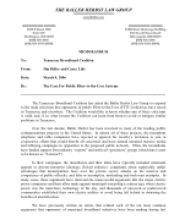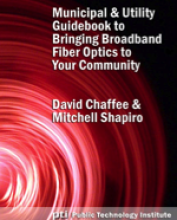
Fast, affordable Internet access for all.

Though Danville, Virginia, was hit hard by the simultaneously decline of tobacco and textile industries, the community has responded: Danville Utilities has been building a state of the art all fiber network. Like many communities, they built a backbone and connected the schools and government buildings first. They then started to connect businesses. This summer they will be rolling out a pilot project to connect a few thousand homes to their open services network. As they add more potential subscribers to the network, they will be more attractive to service providers. This should spur competition, increase innovation, reduce prices, and otherwise make the network more desirable to subscribers. Though the open access idea has been somewhat maligned following the troubles of UTOPIA (many of which had nothing to do with the wholesale model), the consulting firm Design Nine has helped both nDanville and The Wired Road move forward with a revised wholesale-only model. This approach may be gaining traction nationally depending on how the rules for the stimulus grants are written: Stimulating Broadband suggests broadband stimulus funding from USDA will favor "projects that will deliver end users a choice of more than one service provider." Back in Danville, the schools have much faster Internet access while shaving their telecom budgets. Other key features are listed on the network's site, including:
The nDanville Medical Network project has begun to connect a majority of doctor’s offices and medical clinics around the city. The network is already being used by the Danville Regional Medical Center to provide super high speed connectivity to satellite clinics and offices in Danville.
Last year, Last Mile featured an article on the network that includes some numbers, goals, and history of the project. Below is a video that discusses some of the benefits of the network.

The Tennessee Broadband Coalition has asked the Baller Herbst Law Group to respond to the main criticisms that opponents of public Fiber-to-the-User (FTTU) initiatives have raised in Tennessee and elsewhere. The Coalition would like to know whether any of these criticisms is valid, and, if so, what lessons the Coalition can learn from them to avoid or mitigate similar problems in Tennessee. Over the last decade, Baller Herbst has been involved in most of the leading public communications projects in the United States. In almost all of these projects, the incumbent telephone and cable companies have rejected or ignored the locality’s invitation to join in cooperative efforts that would benefit all concerned and have instead mounted massive media and lobbying campaigns in opposition to the proposed public network. Often, the incumbents have funded support from industry “experts” and artificial “grassroots” groups (which have come to be known as “Astroturf”). In their campaigns, the incumbents and their allies have typically included emotional appeals to private-enterprise ideology; flawed statistics; complaints about supposedly unfair advantages that municipalities have over the private sector; attacks on the motives and competency of public officials; and false or incomplete, misleading and irrelevant examples. In many cases, these arguments have mirrored the unsuccessful arguments that the major electric power companies and their allies made against municipal ownership a century ago, when electric power was the must-have technology of the day, and thousands of unserved or underserved communities established their own electric utilities to avoid being left behind in obtaining the benefits of electrification.

The Municipal & Utility Guidebook to Bringing Broadband Fiber Optics to Your Community is a free, comprehensive guide to the economic and quality-of-life benefits of robust fiber infrastructure. It examines in detail four communities that have successfully deployed fiber-to-the-home (FTTH) services to their citizens and businesses. “This guidebook helps government leaders build a strong case for investing in FTTH infrastructure,“ said Alan Shark, Executive Director of PTI. “With thorough analysis, interviews and painstaking research, it sets forth strategies that, if followed, will help American communities whose broadband needs are not being met by current market dynamics to prosper in the information age.“